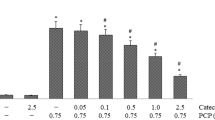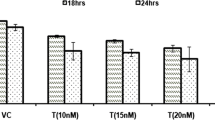Abstract
The aim of this study is to show that protective effects of the main catechin (−)-epigallocatechin-3-gallate (EGCG) against capsaicin (CAP) induced oxidative stress and DNA damage in human blood in vitro. Superoxide dismutase, catalase, glutathione peroxidase and malondialdehyde (MDA) level were studied in erythrocytes and leucocytes with increased concentrations of CAP. DNA damage in leucocytes was measured by the comet assay. Human blood cells have been administered with doses between 0 and 200 μM of CAP and/or EGCG (20 μM) for an hour at 37 °C. Treatment with CAP alone has increased the levels of MDA and decreased antioxidant enzymes in human blood cells. A significant increase in tail DNA%, mean tail length and tail moment indicating DNA damage has been observed at the highest dose of CAP treatment when compared to controls. Treatment of cells with CAP plus EGCG prevented CAP-induced changes in antioxidant enzyme activities and MDA level and mean tail lenght indicating DNA damage. A significant increase in mean tail lenght was observed at high doses of CAP. These data suggest that EGCG can prevent toxicity to human erythrocytes and leucocytes caused by CAP, only at low doses.


Similar content being viewed by others
Referencess
Aebi H (1984) Catalase in vitro. Methods Enzymol 105:121–126
Agarwal RC, Wiessler M, Hecker E, Bhide SV (1986) Tumor promoting effects of chilli extracts in BALB/c mice. Int J Cancer 38:689–695
Anandakumar P, Kamaraj S, Jagan S, Ramakrishnan G, Vinodhkumar R, Devaki T (2008) Stabilization of pulmonary mitochondrial enzyme system by capsaicin during benzo(a)pyrene induced experimental lung cancer. Biomed Pharmacother 62:390–394
Anandan R, Devi KP, Devaki T, Govindaraju P (1998) Preventive effects of Picrorhiza kurroa on D-galatosamine-induced hepatitis in rats. Ind J Exp Biol 1:87–95
Anderson D, Yu TW, McGregor DB (1998) Comet assay responses as indicators of carcinogen exposure. Mutagenesis 13:539–555
Anderson RF, Fisher LJ, Hara Y, Harris T, Mak WB, Melton LD, Packer JE (2001) Green tea catechins partially protect DNA from –OH radical induced strand breaks and base damage through fast chemical repair of DNA radicals. Carcinogenesis 22:1189–1193
Banji D, Banji OJF, Reddy M, Annamalai AR (2013) Impact of zinc, selenium and lycopene on capsaicin induced mutagenicity and oxidative damage in mice. J Trace Elem Med Biol 27:230–235
Bauer JD, Ackermann PG, Toro G (1974) Clinical laboratory methods. Mosby Company, London, p 97
Behravan J, Mosafa F, Soudmand N, Taghiabadi E, Razavi BM, Karimi G (2011) Protective effects of aqueous and ethanolic extracts of Portulaca oleracea L. aerial parts on H2O2-induced DNA damage in lymphocytes by comet assay. Acupunct Meridian Stud 4:193–197
Bukowska B (2003) Effect of 2,4-D and its metabolite 2,4-dichlorophenol on antioxidant enzymes and level of glutathione in human erythrocytes. Comp Biochem Physiol 135:435–441
Celik A, Eke D, Ekinci SY, Yıldırım S (2013) The protective role of curcumin on perfluorooctane sulfonate-induced genotoxicity: single cell gel electrophoresis and micronucleus test. Food Chem Toxicol 53:249–255
Chan MM, Soprano KJ, Weinstein K, Fong D (2006) Epigallocatechin-3-gallate delivers hydrogen peroxide to induce death of ovarian cancer cells and enhances their cisplatin susceptibility. J Cell Physiol 207:389–396
Cordell GA, Araiyo OE (1993) Capsaicin identification, nomenclature and pharmacotherapy. Ann Pharmacother 27:330–336
Cotelle S, Ferard JF (1999) Comet assay in genetic ecotoxicology: a review. Environ Mol Mutagen 34:246–255
Crespy V, Williamson G (2004) A review of the health effects of green tea catechins in in vivo animal models. J Nutr 134:3431–3440
Devika PT, Stanely Mainzen Prince P (2008) (−)-Epigallocatechingallate protects the mitochondria against the deleterious effects of lipids, calcium and adenosine triphosphate in isoproterenol induced myocardial infarcted male Wistar rats. J Appl Toxicol 28:938–944
Dhawan A, Anderson D, de Pascual-Teresa S, Santos-Buelga C, Clifford MN, Ioannides C (2002) Evaluation of the antigenotoxic potential of monomeric and dimeric flavanols, and black tea polyphenols against heterocyclic amine-induced DNA damage in human lymphocytes using the Comet assay. Mutat Res 515:39–56
Diaz Barriga-Areos S, Madrigal-Bujaidar E, Calderon-Montellano E, Ramirez-Herrera L, Diaz-Garcia BD (1995) Genotoxic effects produced by capsaicin in mouse during subchronic treatment. Mutat Res/Gen Toxicol 345:105–109
Drabkin DI (1946) Spectrophotometric studies. XIV. The crystallographic and optical properties of the hemoglobin of man in comparison with those of other species. J Biol Chem 164:703–723
Fairbairn DW, Olive PL, O’Neill KL (1995) The comet assay: a comprehensive review. Mutat Res 339:37–59
Fridovich I (1975) SOD. Annu Rev Biochem 44:147–159
Fujiki H, Yoshizawa S, Horiuchi T, Suganuma M, Yatsunami J, Nishiwaki S, Okabe S, Nishiwaki-Matsushima R, Okuda T, Sugimura T (1992) Anticarcinogenic effects of (−)-epigallocatechin gallate. Prev Med 21:503–509
Fujita Y, Yamane T, Tanaka M, Kuwata K, Okuzumi J, Takahashi T, Fujiki H, Okuda T (1989) Inhibitory effect of (−)-epigallocatechin gallate on carcinogenesis with N-ethyl-N′-nitro-N-nitrosoguanidine in mouse duodenum. Jpn J Cancer Res 80:503–505
Glei M, Pool-Zobel BL (2006) The main catechin of green tea, (−)-epigallocatechin-3-gallate (EGCG), reduces bleomycin-induced DNA damage in human leucocytes. Toxicol In Vitro 20:295–300
Glei M, Matuschek M, Steiner C, Bohm V, Persin C, Pool-Zobel BL (2003) Initial in vitro toxicity testing of functional foods rich in catechins and anthocyanins in human cells. Toxicol In Vitro 17:723–729
International Agency for Research on Cancer (1991) Monographs on the evaluation of carcinogenic risk to humans. Coffee, tea, mate, methylxanthine and methylglyoxal, vol 51. IARC press, Lyon, pp 201–271
Jones PA (1984) Gene activation by 5-azacytidine. In: Razin A, Cedar H, Riggs AD (eds) DNA methylation: biochemistry and biological significance. Springer, New York, pp 165–188
Jones PA, Buckley JD (1990) The role of DNA methylation in cancer. Adv Cancer Res 54:1–23
Karthikeyan K, Sarala Bai BR, Niranjali Devaraj S (2007) Cardioprotective effect of grape seed proanthocyanidins on isoproterenol-induced myocardial injury in rats. Int J Cardiol 115:326–333
Kirkland D, Speit G (2008) Evaluation of the ability of a battery of three in vitro genotoxicity tests to discriminate rodent carcinogens and non-carcinogens III. Appropriate follow-up testing in vivo. Mutat Res 654:114–132
Konyalioglu S, Karamenderes C (2005) The protective effects of Achillea L. species native in Turkey against H2O2-induced oxidative damage in human erythrocytes and leucocytes. J Ethnopharmacol 102:221–227
Kumar P, Kumar A (2009) Effect of lycopene and epigallocatechin-3-gallate against 3-nitropropionic acid induced cognitive dysfunction and glutathione depletion in rat: a novel nitric oxide mechanism. Food Chem Toxicol 47:2522–2530
Lambert JD, Elias RJ (2010) The antioxidant and pro-oxidant activities of green tea polyphenols: a role in cancer prevention. Arch Biochem Biophys 501:65–72
Lecumberri E, Dupertuis YM, Miralbell R, Pichard C (2013) Green tea polyphenol epigallocatechin-3-gallate (EGCG) as adjuvant in cancer therapy. Clin Nutr 32:894–903
Lee YK, Cho YC (1997) Sister chromatid exchanges (SCE) in cultured human lymphocytes induced by cadmium, selenium and zinc. Kor J Environ Health Soc 23:26–32
Lowry OH, Rosebrough NJ, Farr AL, Randall RJ (1951) Protein measurement with the folin phenol reagent. J Biol Chem 193:265–275
Marklund S, Marklund G (1974) Involvement of the superoxide anion radical in the autoxidation of pyrogallol and a convenient assay for superoxide dismutase. Eur J Biochem 47:469–474
Marques S, Oliveira NG, Chaveca T, Rueff J (2002) Micronuclei and sister chromatid exchanges induced by capsaicin in human lymphocytes. Mutat Res 517:39–46
McKelvey-Martin VJ, Green MHL, Schmezer P, Pool-Zobel BL, De Meo MP, Collins A (1993) The single cell gel electrophoresis assay (comet assay): a European review. Mutat Res 288:47–63
Mukherjee S, Banerjee SK, Maulik M, Dinda AK, Talwar KK, Maulik SK (2003) Protection against adriamycin-induced cardiotoxicity by garlic: role of endogenous antioxidants and inhibition of TNF-a expression. BMC Pharmacol 3:1–9
Ohkawa H, Ohishi N, Yagi K (1979) Assay for lipid peroxides in animal tissues by thiobarbituric acid rection. Anal Biochem 95:351–358
Ozkan D, Yuzbasıoglu D, Unal F, Yılmaz S, Aksoy H (2009) Evaluation of the cytogenetic damage induced by the organophosphorous insecticide acephate. Cytotechnology 59:73–80
Padma VV, Lalitha G, Shirony NP, Baskaran R (2012) Effect of quercetin against lindane induced alterations in the serum and hepatic tissue lipids in wistar rats. Asian Pac J Trop Biomed 2:910–915
Paglia DE, Valentine WN (1967) Studies on the quantative and qualitative characterization of glutathione peroxidase. J Lab Med 70:158–169
Pool-Zobel BL, Klein RG, Liegebel UM, Kuchenmeister F, Weber S, Schnezer P (1992) Systemic genotoxic effect of tobaccorelated nitrosamines following oral and inhalation administration to Sprague-Dawley rats. Clin Investig 70:299–306
Rice-Evans CA, Miller J, Paganga G (1997) Antioxidant properties of phenolic compounds. Trends Plant Sci 2:152–159
Richeux F, Cascante M, Ennamany R, Saboureau D, Creppy EE (1999) Cytotoxicity and genotoxicity of capsaicin in human neuroblastoma cells SHSY-5Y. Arch Toxicol 73:403–409
Sanghvi LD (1981) Cancer epidemiology: ındian scene. Cancer Res Clin Oncol 99:1–14
Sharma SK, Vij AS, Sharma S (2013) Mechanisms and clinical uses of capsaicin. Eur J Pharmacol 720:55–62
Shimeda Y, Hirotani Y, Akimoto Y, Shindou K, Ijiri Y, Nishihori T, Tanaka K (2005) Protective effects of capsaicin against cisplatin-induced nephrotoxicity. Biol Pharm Bull 28:1635–1638
Singh NP, McCoy MT, Tice RR, Schneider EL (1988) A simple technique for quantification of low levels of DNA damage in individual cells. Exp Cell Res 175:184–191
Surh YJ (1999) Molecular mechanisms of chemopreventive effects of selected dietary and medicinal phenolic substances. Mutat Res 428:305–327
Surh YJ, Lee SS (1995) Capsaicin, a double-edged sword: toxicity, metabolism, and chemopreventive potential. Life Sci 56:1845–1855
Surh YJ, Lee SS (1996) Capsaicin in hot chilli pepper: carcinogen, cocarcinogen or anticarcinogen? Food Chem Toxicol 34:313–316
Toth B, Gannett P (1992) Carcinogenicity of lifelong administration of capsaicin of hot pepper in mice. In Vivo 6:59–63
Toth B, Rogan E, Walker B (1984) Tumorigenicity and mutagenicity studies with capsaicin of hot peppers. Anticancer Res 4:117–119
Vijayalakshmi T, Muthulakshmi V, Sachnanandam P (1997) Salubrious effect of Semecarpus anacardium against lipid peroxidative changes in adjuvant arthritis-studied in rats. Mol Cell Biochem 175:65–69
Vinayaka KS, Nandini KC, Rakshitha MN, Ramya M, Shruthi J, Shruthi V, Prashith KTR, Raghavendra HL (2010) Proximate composition, antibacterial and anthelmintic activity of Capsicum frutescens (L.) Var. Longa (Solanaceae) leaves. Phcog J 2:486–491
Yamane T, Nakatani H, Kikuoka N, Matsumoto H, Iwata Y, Kitao Y, Oya K, Takahashi T (1996) Inhibitory effects and toxicity of green tea polyphenols for gastrointestinal carcinogenesis. Cancer 77:1662–1667
Yang CS, Maliakal P, Meng X (2002) Inhibition of carcinogenesis by tea. Annu Rev Pharmacol Toxicol 42:25–54
Yılmaz S, Unal F, Yuzbasioglu D, Celik M (2014) DNA damage in human lymphocytes exposed to four food additives in vitro. Toxicol Ind Health (in press)
Yousef MI, Saad AA, El-Shennawy LK (2009) Protective effect of grape seed proanthocyanidin extract against oxidative stress induced by cisplatin in rats. Food Chem Toxicol 47:1176–1183
Zhang G, Wang Y, Zhang Y, Wan X, Li J, Liu K, Wang F, Liu K, Liu Q, Yang C, Yu P, Huang Y, Wang S, Jiang P, Qu Z, Luan J, Duan H, Zhang L, Hou A, Jin S, Hsieh TC, Wu E (2012) Anti-cancer activities of tea epigallocatechin-3-gallate in breast cancer patients under radiotherapy. Curr Mol Med 12:163–176
Acknowledgments
The author would like to thank to Esra GUVEN for helping me to prepare this study.
Conflict of interest
The authors declare that there are no conflicts of interest.
Author information
Authors and Affiliations
Corresponding author
Rights and permissions
About this article
Cite this article
Pandır, D. Protective effect of (−)-epigallocatechin-3-gallate on capsaicin-induced DNA damage and oxidative stress in human erythrocyes and leucocytes in vitro. Cytotechnology 67, 367–377 (2015). https://doi.org/10.1007/s10616-014-9695-2
Received:
Accepted:
Published:
Issue Date:
DOI: https://doi.org/10.1007/s10616-014-9695-2




